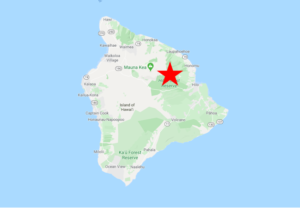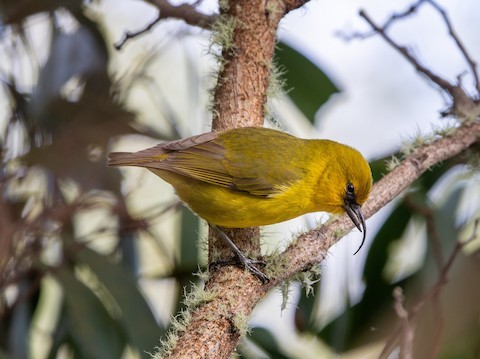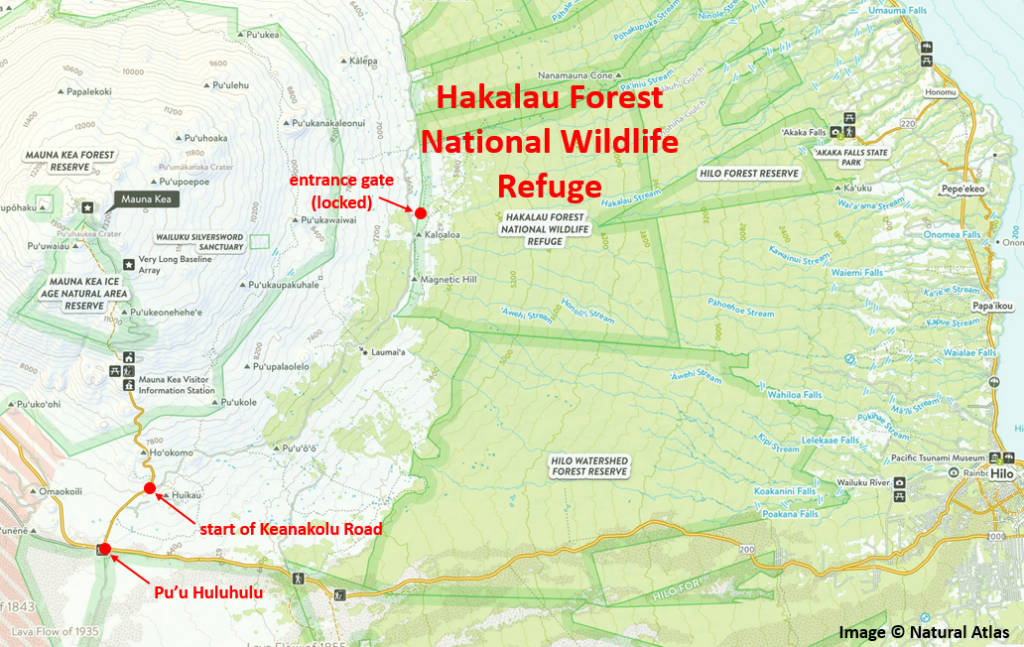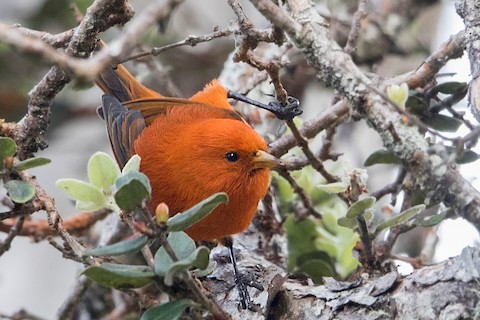Hakalau Forest National Wildlife Refuge, Big Island, Hawaii

On the wet, windward, northeastern flank of Mauna Kea is a remote forested refuge that protects the healthiest remaining populations of three endangered honeycreepers, the Hawaii Akepa, Hawaii Creeper, and the rare and peculiar Akiapola’au. Hakalau Forest is a challenging destination due to both remoteness and protective restrictions on visitor access, requiring the services of a permitted guide. Besides its signature specialties, the refuge is home to several other Hawaiian endemics, including Hawaiian Hawk, Hawaii Elepaio, Oma’o, Apapane, I’iwi, and Common Amakihi.
Orientation
Directions
Hakalau Forest is on the eastern slope of Mauna Kea, about a 90-minute drive (~50 miles) west of Hilo, and two hours’ drive (~75 miles) east of Kailua-Kona.
From Hilo International Airport. Turn left (south) onto Kanoelehua Avenue (which is also the local segment of the Hawaii Belt Road), go one mile, turn right (west) onto Puainako Street (Route 2000). Remain on Puainako through its brief dogleg intersection with Komohana Street at the University of Hawaii – Hilo Campus, then continue west on Puainako which departs Hilo and becomes Saddle Road.
Approximately 26.5 miles from the university, across from the Pu’u Huluhulu Cinder Cone parking area, turn right (north) onto the Mauna Kea Access Road, which is paved. After 2.1 miles, turn right onto the unpaved Keanakolu Road. From this point, it is approximately 16 miles to the most accessible parts of the forest.
From Kona International Airport. Take Route 19 south for 1.2 miles, turn east on Kaiminani Drive, and go 3.6 miles to the T-junction with the Mamalahoa Highway (also part of the Hawaii Belt Road and Route 190).
Turn north on the Belt Road, go 19.4 miles to lower end of Daniel K. Inouye Highway, turn right and take this road for 9.6 miles to its junction with Saddle Road. Turn south onto Saddle Road and go 13.6 miles to its junction with the Mauna Kea Access Road. Turn left (north) and continue as above.
Birdfinding
As part of its effort to combat the spread of Rapid Ohia Death, the U.S. Fish & Wildlife Service has discontinued general public access to Hakalau Forest. For the foreseeable future, all visitors will require the accompaniment of authorized guides.
The remaining native forest habitat is uniquely productive for birds endemic to the Big Island. In particular, the Hawaii Akepa is very common, the Hawaii Creeper is somewhat less numerous but reliably present, and the Akiapola’au is uncommon but usually findable. Three more widespread Big Island endemics are also common in Hakalau Forest: Hawaiian Hawk, Hawaii Elepaio, and Oma’o. The three honeycreepers not confined to the Big Island are also common: Apapane, I’iwi, and Common Amakihi. Most refuge visitors will be less interested in seeing introduced songbirds, but Red-billed Leiothrix is notably common.

The peculiar Akiapola’au is most readily seen at Hakalau Forest National Wildlife Refuge. © William Higgins


Male Hawaii Akepa at Hakalau Forest National Wildlife Refuge. © Bradley Hacker

Hawaii Creeper at Hakalau Forest National Wildlife Refuge. © Bradley Hacker
On the long drive along Keanakolu Road, open country birds that are generally present include: Hawaiian Goose, California Quail, Wild Turkey, Erckel’s Francolin, Common and Kalij Pheasants, Hawaiian Hawk, “Hawaiian Short-eared Owl”, and Eurasian Skylark. Less expected but possible are: Chukar and Black and Gray Francolins. Finally, two species of introduced quail that are generally rare in Hawaii have been found occasionally and worth keeping in mind: Gambel’s and Japanese.
Services
Tour Operators
Since the late 2010s, only guided visits to the refuge have been allowed. The following local tour operators are authorized:
Hawai`i Bird Guide LLC, 1-808-495-6545, manubirding@gmail.com
Hawai`i Birds LLC, 1-808-964-3535, jjphoto@hawaii.rr.com
Hawai`i Forest and Trail, 1-800-464-1993, 1- 808-331-8505, info@hawaii-forest.com
Hawai`i Nature Explorers, 1-808-895-2350, hawaii4u2c@gmail.com
Kona Adventure Tours, 1-808-987-4284, info@konaadventuretours.com
Notes
Hazards & Hassles
Restricted Access. Although there have been times when the refuge was regularly opened to visitors, the emergence of Rapid Ohia Death as a threat to the habitat has brought ever-tightening restrictions. As of 2020, before the pandemic, visits required hiring a permitted tour operator. The conditions of access are subject to change in the future. Presumably at some point they will return to allowing limited visitation without guides, but this is not guaranteed and there is no clear timetable.
Road Conditions. The last 16 miles of the drive are on unpaved road, where conditions vary depending on the weather and maintenance schedule. This road is resurfaced from time to time, and it is sometimes drivable in a regular passenger car, but it deteriorates and often requires a high-clearance vehicle. The last few miles are often muddy enough to require the use of four-wheel drive.
Weather. The eastern slope of Mauna Kea is among the wettest places in the U.S. The accessible portion of the refuge is around 6,000-6,500’ elevation, so mornings are chilly and it can be cold at any time of day, depending on the weather.
Links